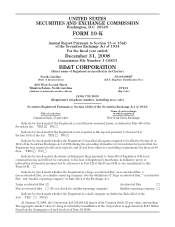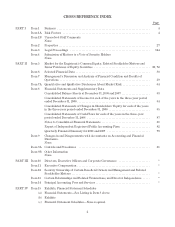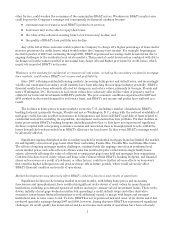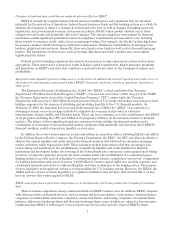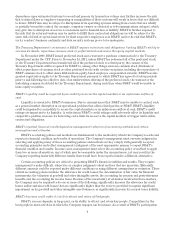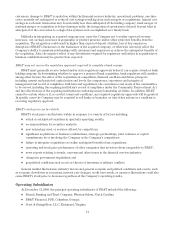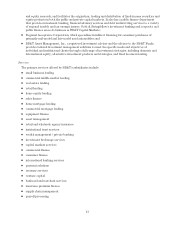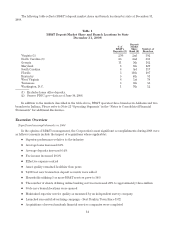BB&T 2008 Annual Report Download - page 5
Download and view the complete annual report
Please find page 5 of the 2008 BB&T annual report below. You can navigate through the pages in the report by either clicking on the pages listed below, or by using the keyword search tool below to find specific information within the annual report.other factors, could weaken the economies of the communities BB&T serves. Weakness in BB&T’s market area
could depress the Company’s earnings and consequently its financial condition because:
Šcustomers may not want or need BB&T’s products or services;
Šborrowers may not be able to repay their loans;
Šthe value of the collateral securing loans to borrowers may decline; and
Šthe quality of BB&T’s loan portfolio may decline.
Any of the latter three scenarios could require the Company to charge off a higher percentage of loans and/or
increase provisions for credit losses, which would reduce the Company’s net income. For example, beginning in
the third quarter of 2007 and continuing through 2008, BB&T experienced increasing credit deterioration due to
ongoing challenges in the residential real estate markets. This period of credit deterioration combined with flat to
declining real estate values resulted in increasing loan charge-offs and higher provisions for credit losses, which
negatively impacted BB&T’s net income.
Weakness in the markets for residential or commercial real estate, including the secondary residential mortgage
loan markets, could reduce BB&T’s net income and profitability.
Since 2007, softening residential housing markets, increasing delinquency and default rates, and increasingly
volatile and constrained secondary credit markets have been affecting the mortgage industry generally. BB&T’s
financial results have been adversely affected by changes in real estate values, primarily in Georgia, Florida and
metro Washington, D.C. Decreases in real estate values have adversely affected the value of property used as
collateral for loans and investments in BB&T’s portfolio. The poor economic conditions experienced in 2007 and
2008 resulted in decreased demand for real estate loans, and BB&T’s net income and profits have suffered as a
result.
The declines in home prices in many markets across the U.S., including a number of markets in BB&T’s
banking footprint (primarily Georgia, Florida and metro Washington, D.C.), along with the reduced availability of
mortgage credit, has also resulted in increases in delinquencies and losses in BB&T’s portfolio of loans related to
residential real estate, including its acquisition, development and construction loan portfolio. Further declines in
home prices within BB&T’s banking footprint (including markets that to date have not experienced significant
declines) coupled with a deepening economic recession and associated rises in unemployment levels could drive
losses beyond the levels provided for in BB&T’s allowance for loan losses. In that event, BB&T’s earnings would
be adversely affected.
Significant ongoing disruption in the secondary market for residential mortgage loans has limited the market
for and liquidity of most mortgage loans other than conforming Fannie Mae, Freddie Mac and Ginnie Mae loans.
The effects of ongoing mortgage market challenges, combined with the ongoing correction in residential real
estate market prices and reduced levels of home sales has resulted in price reductions in single family home
values, adversely affecting the value of collateral securing mortgage loans held and mortgage loan originations.
Continued declines in real estate values and home sales volumes within BB&T’s banking footprint, and financial
stress on borrowers as a result of job losses, or other factors, could have further adverse effects on borrowers
that result in higher delinquencies and greater charge-offs in future periods, which would adversely affect
BB&T’s financial condition and results of operations.
Market developments may adversely affect BB&T’s industry, business and results of operations.
Significant declines in the housing market in recent months, with falling home prices and increasing
foreclosures and unemployment, have resulted in significant write-downs of asset values by many financial
institutions, including government-sponsored entities and major commercial and investment banks. These write-
downs, initially of mortgage-backed securities but spreading to credit default swaps and other derivative
securities, caused many financial institutions to seek additional capital, to merge with larger and stronger
institutions and, in some cases, to fail. To date, BB&T has not experienced material asset write downs and it has
produced quarterly earnings during 2007 and 2008, however, during this time BB&T has experienced significant
challenges, its credit quality has deteriorated and its net income and results of operations have been adversely
5

